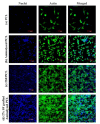Hydrophilic Surface Functionalization of Electrospun Nanofibrous Scaffolds in Tissue Engineering
- PMID: 33182617
- PMCID: PMC7697875
- DOI: 10.3390/polym12112636
Hydrophilic Surface Functionalization of Electrospun Nanofibrous Scaffolds in Tissue Engineering
Abstract
Electrospun polymer nanofibers have received much attention in tissue engineering due to their valuable properties such as biocompatibility, biodegradation ability, appropriate mechanical properties, and, most importantly, fibrous structure, which resembles the morphology of extracellular matrix (ECM) proteins. However, they are usually hydrophobic and suffer from a lack of bioactive molecules, which provide good cell adhesion to the scaffold surface. Post-electrospinning surface functionalization allows overcoming these limitations through polar groups covalent incorporation to the fibers surface, with subsequent functionalization with biologically active molecules or direct deposition of the biomolecule solution. Hydrophilic surface functionalization methods are classified into chemical approaches, including wet chemical functionalization and covalent grafting, a physiochemical approach with the use of a plasma treatment, and a physical approach that might be divided into physical adsorption and layer-by-layer assembly. This review discusses the state-of-the-art of hydrophilic surface functionalization strategies of electrospun nanofibers for tissue engineering applications. We highlighted the major advantages and drawbacks of each method, at the same time, pointing out future perspectives and solutions in the hydrophilic functionalization strategies.
Keywords: electrospinning; immobilization; nanofiber; polymers; surface functionalization; tissue engineering.
Conflict of interest statement
The authors declare no conflict of interest.
Figures




References
-
- Carvalho J., Carvalho P., Gomes D., Goes A. Chapter 11—Innovative Strategies for Tissue Engineering. In: Pignatello R., editor. Advances in Biomaterials Science and Biomedical Application. IntechOpen; London, UK: 2013. pp. 295–313.
Publication types
Grants and funding
LinkOut - more resources
Full Text Sources

